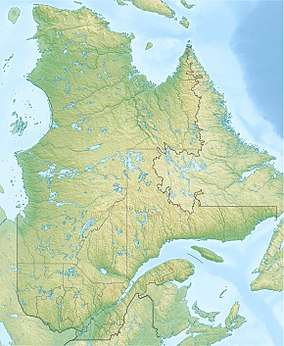Ours River (Minganie)
The Ours River (French: Rivière à l'Ours, Bear River) is a river in the Côte-Nord region of Quebec, Canada. It empties into the Gulf of Saint Lawrence.
| Ours River Rivière à l'Ours | |
|---|---|
 | |
| Location | |
| Country | Canada |
| Province | Quebec |
| Region | Côte-Nord |
| RCM | Minganie |
| Physical characteristics | |
| Mouth | Gulf of Saint Lawrence |
⁃ coordinates | 50.298333°N 63.058056°W |
⁃ elevation | 0 metres (0 ft) |
| Basin size | 260 square kilometres (100 sq mi) |
Location
The Ours River has two branches that join about 4 miles (6.4 km) from its mouth on the Gulf of Saint Lawrence. Both have many rapids and small falls, and are impassable by canoe.[1] The mouth of the river is in the municipality of Havre-Saint-Pierre in the Minganie Regional County Municipality.[2] The mouth is in the Mingan Archipelago National Park Reserve. The name "Rivière à l'Ours" appears on a map dated 1960, and was made official on 5 December 1968.[3]
Basin
The river drains Lac à l'Ours, Lac Kakuahkuepaniuhiht, Lac Malville, Petit lac Uatnakantuk, Lac à la Peur, Lac Mannier and Lac Cormier.[3] The river basin covers 260 square kilometres (100 sq mi). It lies between the basins of the Romaine River to the west and the Corneille River to the east.[4] It is partly in the unorganized territory of Lac-Jérôme and partly in the municipality of Havre-Saint-Pierre.[5] The region around Lac à l'Ours can be reached by canoe from the Romaine, Puyjalon and Ours rivers, with only a few short portages, but the easiest access is by float plane. The region was explored by Henry de Puyjalon, Joseph Obalski and James Richardson[lower-alpha 1] around the end of the 19th century, and various geologists visited the region after that.[7]
Terrain
The coastal plain is flat and marshy, with a layer of marine deposits. Inland the region is a peneplain or plateau in which the bedrock is almost continuously exposed. The surface is very irregular, deeply incised by many V-shaped valleys whose direction is determined by shear zones, faults, and by glacial action along the joints parallel to the ice movement. Average elevations of the hills are 400 feet (120 m), with the river bottoms 200 feet (61 m) lower.[8]
Environment
A map of the ecological regions of Quebec shows the river in sub-regions 6j-T and 6m-T of the east spruce/moss subdomain.[9] As of 1966 most of the region had no trees, since a forest fire twenty years earlier had destroyed almost all the vegetation and burned the thin layer of humus that covered the rock. There were some trees remaining along the rivers, mostly balsam fir, spruce, birch and aspen. The area had many beaver, which were trapped by the Indians of the Mingan Reserve, but not so much as to wipe them out. Other common animals included otter, mink, hare, partridge, duck, bear and fox. There were few caribou or moose. The lakes hold landlocked salmon and brook trout.[10]
Notes
- James Richardson (1810-1883) was a Scottish immigrant to Canada who worked as a farm laborer, then a teacher before being engaged as an assistant on a series of expeditions by the Geological Survey of Canada. He was appointed a permanent "explorer" by the Geological Survey in 1856, having learned the basics of geology in the field. He undertook extensive and valuable work in Newfoundland and Quebec, and later in British Columbia. He was the first in Canada (in 1860) to photograph geological features. Richardson Inlet in the Queen Charlotte Islands was named in is honor in 1878 by George Mercer Dawson.[6]
Citations
- Depatie 1966, p. 7.
- Rivière à l'Ours, Natural Resources.
- Rivière à l'Ours, Commission.
- Portrait préliminaire de la zone ... OBVD, p. 20.
- Portrait préliminaire de la zone ... OBVD, p. 64.
- Richeson 2003.
- Depatie 1966, p. 3.
- Depatie 1966, p. 6.
- Saucier et al. 2011.
- Depatie 1966, p. 5.
Sources
- Depatie, J.-J (1966), Region du Lac à l'Ours (PDF) (in French), Gouvernement du Québec, Service de l'Exploration géologique, retrieved 2019-10-02
- Portrait préliminaire de la zone de gestion intégrée de l'eau par bassin versant Duplessis (PDF) (in French), OBV Duplessis, April 2015, retrieved 2019-10-01
- Richeson, David R. (2003), "RICHARDSON, JAMES", Dictionary of Canadian Biography, University of Toronto/Université Laval, 11, retrieved 2019-10-02
- Rivière à l'Ours (in French), Commission de toponymie du Québec, retrieved 2019-10-02
- Rivière à l'Ours, Natural Resources Canada, retrieved 2019-10-02
- Saucier, J.-P.; Robitaille, A.; Grondin, P.; Bergeron, J.-F.; Gosselin, J. (2011), Les régions écologiques du Québec méridional (PDF) (map), 4 (in French), Ministère des Ressources naturelles et de la Faune, retrieved 2019-10-01